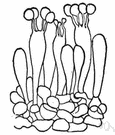spicule
Also found in: Thesaurus, Medical, Encyclopedia, Wikipedia.
Related to spicule: spongin
spic·ule
(spĭk′yo͞ol) also spic·u·la (-yə-lə)n. pl. spic·ules also spic·u·lae (-yə-lē)
1. A small needlelike structure or part, such as one of the silicate or calcium carbonate processes supporting the soft tissue of certain invertebrates, especially sponges.
2. Astronomy A spike-shaped formation emanating from the ionized gas of the solar photosphere.
[Latin spīculum; see spiculum.]
spic′u·lar (-yə-lər), spic′u·late (-yə-lĭt, -lāt′) adj.
American Heritage® Dictionary of the English Language, Fifth Edition. Copyright © 2016 by Houghton Mifflin Harcourt Publishing Company. Published by Houghton Mifflin Harcourt Publishing Company. All rights reserved.
spicule
(ˈspɪkjuːl)n
1. (Biology) Also called: spiculum a small slender pointed structure or crystal, esp any of the calcareous or siliceous elements of the skeleton of sponges, corals, etc
2. (Astronomy) astronomy a spiked ejection of hot gas occurring over 5000 kilometres above the sun's surface (in its atmosphere) and having a diameter of about 1000 kilometres
[C18: from Latin: spiculum]
spiculate adj
Collins English Dictionary – Complete and Unabridged, 12th Edition 2014 © HarperCollins Publishers 1991, 1994, 1998, 2000, 2003, 2006, 2007, 2009, 2011, 2014
spic•ule
(ˈspɪk yul)n.
1. a small, needlelike crystal, process, or the like.
2. one of the small, hard, calcareous or siliceous bodies that serve as the skeletal elements of various marine and freshwater invertebrates.
[1775–85; < Latin spīculum]
spic′u•late` (-yəˌleɪt, -lɪt) adj.
Random House Kernerman Webster's College Dictionary, © 2010 K Dictionaries Ltd. Copyright 2005, 1997, 1991 by Random House, Inc. All rights reserved.
spic·ule
(spĭk′yo͞ol) A needle-like structure or part, such as one of the mineral structures supporting the soft tissue of certain invertebrates, especially sponges.
The American Heritage® Student Science Dictionary, Second Edition. Copyright © 2014 by Houghton Mifflin Harcourt Publishing Company. Published by Houghton Mifflin Harcourt Publishing Company. All rights reserved.
ThesaurusAntonymsRelated WordsSynonymsLegend:
Switch to new thesaurus
| Noun | 1. |  spicule - small pointed structure serving as a skeletal element in various marine and freshwater invertebrates e.g. sponges and corals spicule - small pointed structure serving as a skeletal element in various marine and freshwater invertebrates e.g. sponges and corals |
Based on WordNet 3.0, Farlex clipart collection. © 2003-2012 Princeton University, Farlex Inc.
Translations
spic·ule
n. espícula, cuerpo en forma de aguja.
English-Spanish Medical Dictionary © Farlex 2012